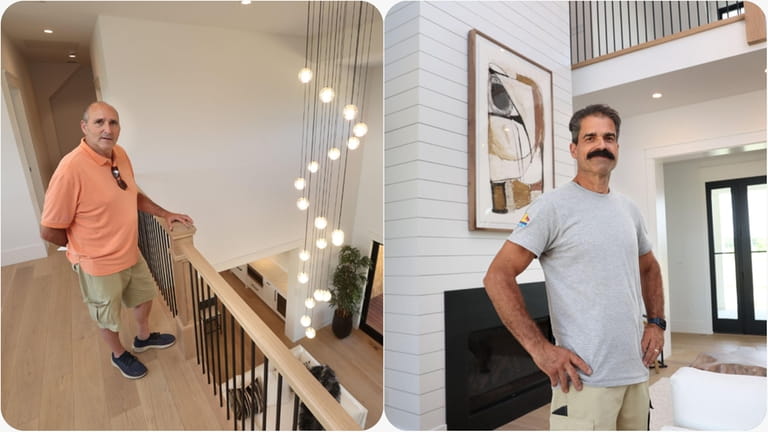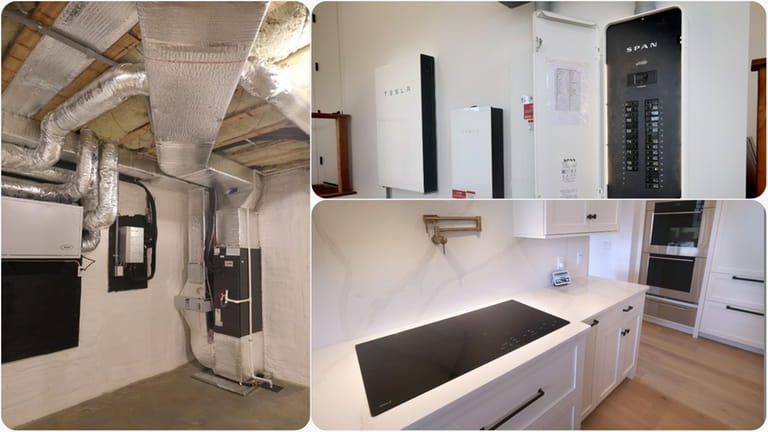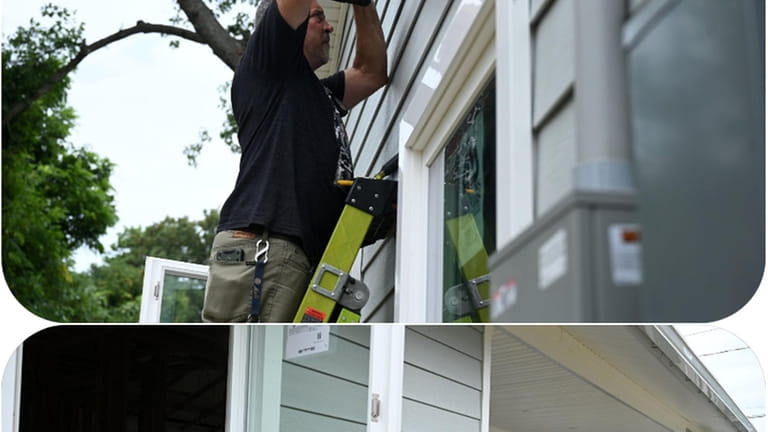Long Island developers use solar panels, more to create green homes
Long Islanders looking for environmentally friendly homes are starting to gain more options, as local developers bet that homebuyers will want to go green and potentially save money in the process.
Two organizations are making that bet at vastly different price points.
Marc Weissbach, a 56-year-old architect venturing into development, has planned 29 homes in a subdivision built on about 30 acres in Baiting Hollow, part of the Town of Riverhead. The first home, which was recently completed, sits on a street that marks a path to the Baiting Hollow Golf Club and has distant views of its fairways from the second floor.
The 3,200-square-foot Modern Farmhouse-style home, with four bedrooms and 3½ bathrooms, has all the hallmarks of luxury living — high ceilings, top-of-the-line appliances, a three-car garage and a $2.1 million asking price.
In Wyandanch, Rick Wertheim, 61, is spearheading construction of the United Way of Long Island’s latest energy-efficient home on a corner lot that it acquired for free from the Suffolk County Landbank, which works to redevelop distressed properties.
United Way plans to sell the home for below market value, aiming for between $400,000 and $415,000, depending on finishing costs, Wertheim said. A lottery for the three-bed, two-bath home — which is in a neighborhood of single-family houses near Wyandanch Memorial High School — is open through Sept. 30, he added.
Both will be net-zero energy-ready homes, which means the properties can produce most, if not all, the energy they use annually. For these homes, that will be accomplished through solar panels.
"When a homebuyer comes in, we’ll be able to let them know exactly how much renewable energy … will offset their energy use," Weissbach said. "Net-zero energy-ready means when you come in, we could have this so that your carbon footprint would be zero."
Inside newly constructed luxury green home

Developer Marc Weissbach and builder Jason Leonard are working on a planned 29-home subdivision built on about 30 acres in Baiting Hollow. Credit: John Paraskevas
Weissbach, who lives in Merrick, isn’t the first to try developing the 30-acre subdivision. Another developer planned to build 30 houses there in 2006 but ran into financial trouble during the 2008 housing crash and went into foreclosure.
Weissbach runs Baiting Hollow Development Group with his wife, Shari, 56, an attorney. They bought the land for $3.5 million in 2021 from Suffolk County through a foreclosure sale overseen by the county referee.
The development's first completed house, 30 Club Drive, features a smart home system that controls the lights, temperature and security system; Wolf and Sub-Zero appliances; a Tesla Powerwall, which provides battery storage for the home’s solar panels; and a whisper-quiet heat pump, which runs its heating and air conditioning. It also includes a Span smart electrical panel that allows the homeowner to control the home's circuits from their phones.
The Baiting Hollow homes have smart panels in several rooms and spray foam insulation on all foundation walls. Credit: John Paraskevas
"One of the biggest differences is the use of all electric here, where normally there’s some sort of fossil fuels," said Jason Leonard, 53, the project's general contractor and owner of JCL Contracting in Southold. The exceptions are a gas-powered fireplace and barbecue grill.
The majority of the energy costs of the home, from heating, cooling, lighting and appliances, will total about $3,098 a year, according to an analysis by Glenn LaMay, owner of Home Energy Solutions, a Huntington-based energy modeling company. That represents a 32% savings, compared with a house that was merely built to meet current state building codes, which would have a $4,559 annual bill.
The home is equipped to accommodate additional solar panels, at a buyer's discretion, to lower that bill further, Weissbach said.
The tens of thousands in upfront equipment and installation costs are reflected in the home’s lofty price. But special attention to insulation and the use of a heat pump are available to more homeowners.
"Heat pumps are the most efficient HVAC systems on the market today," said Donovan Gordon, director of clean heating and cooling at the New York State Energy Research and Development Authority.

Energy efficient details include tightly sealed ductwork, left, a Tesla Power Wall and Span smart electric panel, top, and an induction cooktop, bottom. Credit: John Paraskevas
Gordon recommends that Long Islanders seek out a home energy assessment audit, which are offered for free to customers of PSEG Long Island, to determine whether addressing insulation, roofing or window issues could lower energy costs.
For those interested in installing heat pumps, PSEG Long Island offers rebates and NYSERDA provides information on state and federal tax credits, which can cover about 30% of the cost of improvements under the Inflation Reduction Act.
The development is also a bet that well-heeled buyers will choose to buy vacation homes in Baiting Hollow, which offers a shorter trip than the most popular vacation home spots on the North Fork and in the Hamptons.
The area is less developed than trendier East End destinations, with plant nurseries, sod farms and Long Island Poultry, a local chicken farm, lining the drive from the Long Island Expressway. Baiting Hollow Farm Vineyard and The Riverhead Ciderhouse are a short drive from the development.
Weissbach hopes buyers who want to spend weekends farther east on the North Fork or in the Hamptons will opt for his homes to cut their driving time by up to an hour.
"We sit at the gateway to the North Fork," Weissbach said. "Between Orient Point and Manhattan, you’re not getting there without passing through here."
New construction, energy efficient, under market value
Rick Wertheim of United Way of Long Island holds a structural insulated panel in a nearly completed Wyandanch home. Credit: Danielle Silverman
In Wyandanch, Wertheim doesn’t need to worry much about finding a buyer — the opportunity to buy a new construction house for less than market value is a rare opportunity.
But he wants the project to be as efficient as possible to keep costs in check for the United Way and to deliver energy savings for the homebuyer who moves in. To qualify, that buyer will need to earn 80% of area median income or less, which is $86,200 for a single person or $123,100 for a family of four, according to federal guidelines.
"Every home needs to be built like it's a rocket ship; every system is dependent upon the other," Wertheim said. "Our building envelope has to be rock solid."
Controlling the flow of air and preventing the loss of energy is the mission. "On a hot day we don’t want [air] to come in, but on a cold day we don’t want it leaving," he said.
The home’s components all serve that goal. It starts with the structural insulated panels, or SIPs, that make up the exterior. The panels, built elsewhere and assembled by Wertheim’s team over three days, have a steel frame with a foam core and a magnesium oxide skin to keep out moisture. The house is also designed to withstand hurricane winds, slow the spread of fires and remain accessible to homeowners as they age in the house.
The home’s field of solar panels, which costs $34,000 including installation, power its heat pump, and an energy recovery ventilator system helps bring in fresh air without adding too much humidity to the house. Wertheim calls these systems the house's "heart and lungs."

Chip Hazlett, top, and Rick Wertheim work on a nearly-completed Wyandanch home. Credit: Danielle Silverman
"I can’t rely on Mother Nature and happenstance," he said. "Most people consider a house needs to breathe. That’s a fallacy. A house needs controlled, balanced ventilation with fresh air changes."
The United Way of Long Island has built 29 homes around the area since 2014, when it became a partner in the U.S. Department of Energy’s Zero Energy Ready Homes program, which has recognized the nonprofit with eight awards for housing innovation.
Wertheim estimated the additional cost of building an Energy Star-certified home, which has lower utility costs, is about $5,000 to $7,000 more than a home that just satisfies local building codes. Adding features to bring the home close to net-zero emissions, including those that improve air quality and conserve water, costs about $25,000 more than only complying with code.
He estimates those costs are covered within seven years in utility savings — but that time can vary based on the degree to which homeowners’ invest in solar panels, access rebates and seek out tax credits.
"Those energy savings get passed down through generations," Wertheim said, "and it’s just a better product because those homes are healthier, they’re safer and they’re more comfortable. There’s never a draft."
Affordable green homes
Retired Army Sgt. Brian Pullis moved into this East Patchogue home, built by United Way, in 2019.
Retired Army Sgt. Brian Pullis, 35, is a believer. In 2019, he moved into one of the United Way’s homes, which was built on the site of a previously abandoned house in East Patchogue that the nonprofit purchased at a reduced price from the Suffolk County Landbank.
"I actually have bad allergies, and I do notice a difference," he said. "Some days I’ll be working and sneezing my butt off, and I’ll go home and it’ll just go away because the air is completely sealed and purified through a purification system."
Pullis’ purchase of the three-bedroom house deepened an already strong connection to the United Way. When the Coram native left the military in 2013 he had trouble transitioning to a civilian career path after three tours in Afghanistan as part of the 82nd Airborne Division's 508th Parachute Infantry Regiment. He was delivering pizzas for a time before finding the United Way’s VetsBuild program, which trained him in green construction and HVAC systems.
As a veteran too, it feels great to know my home was built by veterans learning a skill that could give them a career.
— Retired Army Sgt. Brian Pullis
He landed a job in 2014 with the heating oil supplier Meenan as an HVAC technician, and now lives in the home, built by the VetsBuild program he completed, with his wife, Katelyn, and their 3-month-old daughter, Emily.
"It’s kind of like things went full circle. I worked with the VetsBuild program. Learned the trades with them, and then used the skills I learned to elevate myself to afford a home their program built," Pullis said. "As a veteran too, it feels great to know my home was built by veterans learning a skill that could give them a career."
Pullis bought the home for $397,500 and said his monthly mortgage payment is now about $2,600 a month. The south-facing side of its roof is covered in solar panels and it, too, features a heat pump and energy-recovery ventilator. Most months, he said he pays only a tax charge of $14.95 for electricity, with the bill rising to about $100 in months with less sun. When his solar panels produce more energy than the house uses, the money is banked and credited for future months.
United Way estimated the house saves about $3,200 a year in utility costs, compared with a house built to code. That savings gave Pullis the initial confidence to buy the home and now allows him to spend on projects, such as a new patio.
"Not having the stress of all these other bills made it a lot easier to realize maybe I can actually afford this," he said.
Pullis is required to live in the home for 10 years before he can sell it and keep any money in excess of what he paid for it. He’s optimistic that the home’s energy efficiency and cheap utility bills will be valued by buyers in the future.
What Long Island real estate agents say
The data is mixed on whether homebuyers and real estate agents have started to seek out green homes.
A national survey of about 2,000 real estate agents found that 63% said promoting the energy efficiency of a home was very or somewhat valuable, according to data collected in March by the National Association of Realtors.
When asked about how high-performance homes fare on the market, the majority of respondents said they weren’t sure. So far, surveys have shown these features are more of a priority for buyers of new construction homes than existing ones, which make up the vast majority of Long Island’s housing stock.
"We do tend to see it was those newer homes where it was considered very important to our recent homebuyers to have these different features," said Brandi Snowden, director of member and consumer survey research at the National Association of Realtors.
Margaret Burkett, a real estate agent at Douglas Elliman in Locust Valley, said she hasn't had a buyer ask specifically for eco-friendly features, such as solar panels. "Largely it’s because these days ‘Can you get me any home at all?’ is usually the question."
But Burkett said she could see solar panels adding to a home's value, particularly if they're paid off. “It really depends on the situation, how it looks and the buyer. Some buyers won’t care because they just love the fact they’re not paying for electricity.”
As more of the lots in the Baiting Hollow subdivision hit the market, Weissbach’s bet on green luxury homes will be put to the test.
"We think we’re a little bit early," Weissbach said, "but sometimes that’s what it takes."
Tip: Glenn LaMay, owner of Home Energy Solutions in Huntington, said one budget-friendly way to improve a home’s energy performance is through a foam-insulated cover that goes above a pulldown staircase to an attic. It typically costs a few hundred dollars. “You’ve basically got a hole in your house that in the wintertime the cold air just pours right down there,” he said. “It’s an easy retrofit, nice and clean and with a quick result.”

